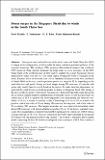| dc.contributor.author | Tkalich, Pavel | |
| dc.contributor.author | Vethamony, P. | |
| dc.contributor.author | Babu, M. T. | |
| dc.contributor.author | Rizzoli, Paola M | |
| dc.date.accessioned | 2017-01-12T20:52:56Z | |
| dc.date.available | 2017-01-12T20:52:56Z | |
| dc.date.issued | 2012-05 | |
| dc.date.submitted | 2011-09 | |
| dc.identifier.issn | 0921-030X | |
| dc.identifier.issn | 1573-0840 | |
| dc.identifier.uri | http://hdl.handle.net/1721.1/106471 | |
| dc.description.abstract | Among the semi-enclosed basins of the world ocean, the South China Sea (SCS) is unique in its configuration as it lies under the main southwest-northeast pathway of the seasonal monsoons. The northeast (NE) monsoon (November–February) and southwest (SW) monsoon (June–August) dominate the large-scale sea level dynamics of the SCS. Sunda Shelf at the southwest part of SCS tends to amplify Sea Level Anomalies (SLAs) generated by winds over the sea. The entire region, bounded by Gulf of Thailand on the north, Karimata Strait on the south, east cost of Peninsular Malaysia on the west, and break of Sunda Shelf on the east, could experience positive or negative SLAs depending on the wind direction and speed. Strong sea level surges during NE monsoon, if coincide with spring tide, usually lead to coastal floods in the region. To understand the phenomena, we analyzed the wind-driven sea level anomalies focusing on Singapore Strait (SS), laying at the most southwest point of the region. An analysis of Tanjong Pagar tide gauge data in the SS, as well as satellite altimetry and reanalyzed wind in the region, reveals that the wind over central part of SCS is arguably the most important factor determining the observed variability of SLAs at hourly to monthly scales. Climatological SLAs in SS are found to be positive, and of the order of 30 cm during NE monsoon, but negative, and of the order of 20 cm during SW monsoon. The largest anomalies are associated with intensified winds during NE monsoon, with historical highs exceeding 50 cm. At the hourly and daily time-scales, SLA magnitude is correlated with the NE wind speed over central part of SCS with an average time lag of 36–42 h. An exact solution is derived by approximating the elongated SCS shape with one-dimensional two-step channel. The solution is utilized to derive simple model connecting SLAs in SS with the wind speeds over central part of SCS. Due to delay of sea level anomaly in SS with respect to the remote source at SCS, the simplified solutions could be used for storm surge forecast, with a lead time exceeding 1 day. | en_US |
| dc.description.sponsorship | Singapore. National Research Foundation (Singapore MIT Alliance for Research and Technology) | en_US |
| dc.description.sponsorship | Singapore-MIT Alliance for Research and Technology. Center for Environmental Sensing and Modeling | en_US |
| dc.publisher | Springer Netherlands | en_US |
| dc.relation.isversionof | http://dx.doi.org/10.1007/s11069-012-0211-8 | en_US |
| dc.rights | Creative Commons Attribution-Noncommercial-Share Alike | en_US |
| dc.rights.uri | http://creativecommons.org/licenses/by-nc-sa/4.0/ | en_US |
| dc.source | Springer Netherlands | en_US |
| dc.title | Storm surges in the Singapore Strait due to winds in the South China Sea | en_US |
| dc.type | Article | en_US |
| dc.identifier.citation | Tkalich, Pavel, P. Vethamony, M. T. Babu, and Paola Malanotte-Rizzoli. “Storm Surges in the Singapore Strait Due to Winds in the South China Sea.” Natural Hazards 66, no. 3 (May 10, 2012): 1345–1362. | en_US |
| dc.contributor.department | Massachusetts Institute of Technology. Department of Earth, Atmospheric, and Planetary Sciences | en_US |
| dc.contributor.mitauthor | Rizzoli, Paola M | |
| dc.relation.journal | Natural Hazards | en_US |
| dc.eprint.version | Author's final manuscript | en_US |
| dc.type.uri | http://purl.org/eprint/type/JournalArticle | en_US |
| eprint.status | http://purl.org/eprint/status/PeerReviewed | en_US |
| dc.date.updated | 2016-08-18T15:19:23Z | |
| dc.language.rfc3066 | en | |
| dc.rights.holder | Springer Science+Business Media B.V. | |
| dspace.orderedauthors | Tkalich, Pavel; Vethamony, P.; Babu, M. T.; Malanotte-Rizzoli, Paola | en_US |
| dspace.embargo.terms | N | en |
| dc.identifier.orcid | https://orcid.org/0000-0003-2431-6838 | |
| mit.license | OPEN_ACCESS_POLICY | en_US |
| mit.metadata.status | Complete | |
